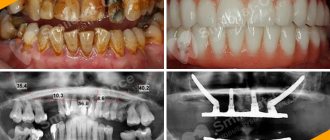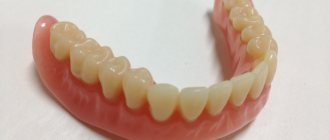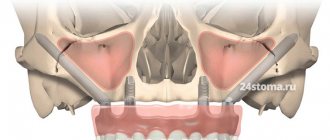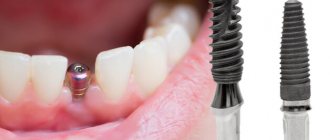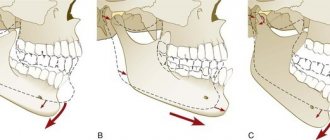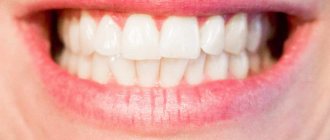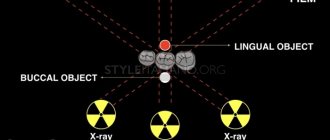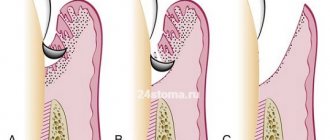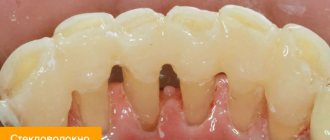Complete edentia or absence of teeth is a serious problem, which is characterized not only by an aesthetic defect, but also by serious disorders: the inability to chew and normal speech functions, structural changes in the bone tissue of the jaws, changes in facial proportions. This not only causes discomfort, but is also fraught with consequences in the form of diseases of the gastrointestinal tract.
You can restore a high quality of life by restoring your teeth. Implantation in the absence of teeth is a modern solution that has replaced removable dentures. It allows you to restore missing teeth and is devoid of the characteristic disadvantages of removable dentures: unreliable fixation, discomfort and gag reflex when worn, and the likelihood of falling out of the mouth.
Advantages of implantation for edentulous patients
Jaw implantation in the absence of teeth has many advantages compared to other types of restoration:
- Reliability of fixation. There is no risk of the structure falling out of the oral cavity or its displacement.
- Prevention of bone loss. Atrophy of the jaw bone occurs due to the lack of proper load - it falls on the soft tissues when wearing removable structures. When installing a prosthesis on implants, the bone tissue receives the proper mechanical chewing load, so no structural changes occur in it for a long time, the volume remains the same.
- Features of care. Some implantation methods do not involve removing the prosthesis at night; in the case of removable prosthetics, this is a mandatory measure.
- Wearing comfort. The pressure on the soft tissues of the oral cavity is minimal, their smaller area is involved, which makes it easier to get used to, prevents pain, avoids speech defects and difficulties in chewing food.
Differences between express dental implantation methods –
So which method of express dental implantation is better to choose? In this case, everything will depend on your budget, and what is very important – the volume of bone tissue in the implantation area. We will once again show you x-rays in which you can see a comparison of the basal technique and the “All-on-4” (Fig. 11). And as you will see below, the number of implants actually matters because... “All-on-4”, in our opinion and the experience of many of our colleagues, still cannot be recommended for the vast majority of patients with complete absence of teeth in the jaw.
In what cases is it better to do basal implantation?
1) One of the most important differences between basal implantation is that, if desired, you can immediately receive a permanent fixed prosthesis. For the All-on-4 technique, this option is excluded, and in any case, you will be forced to first make a temporary (adaptation) fixed denture, which will subsequently need to be replaced with a permanent one. But the basal implantation technique gives the patient a choice.
Those. you can still choose two-stage prosthetics, which will allow you to save on the first stage (in this case, you will first pay only from 250,000 to 320,000 rubles - depending on the cement or screw type of prosthesis fixation), but you will only receive a temporary fixed prosthesis . And at the second stage, you will have to pay about another 250,000 to 320,000 rubles for a fixed permanent prosthesis (also depending on the type of fixation). Or the second option - for 580,000 rubles you can immediately get a permanent fixed prosthesis with a titanium frame and screw fixation.
The only clarification is that there is also such a technique as All-on-3, which translates as “all on three implants.” This technique is performed only on the lower jaw, and it means that your fixed denture will be supported by only 3 dental implants. So, with this method, you will also immediately be given a permanent fixed denture (but for “All-on-4” or “All-on-6” this is impossible).
2) If there is a very thin alveolar ridge in the lower jaw, it will probably also be better to choose basal implantation. The fact is that a big problem for patients with complete absence of teeth and long-term experience of wearing removable dentures is the thinning of the alveolar ridge of the lower jaw (24stoma.ru). Ideally, complete dental implantation on the jaw is carried out with an alveolar ridge width of 5.0 mm or more, but very often patients come with a ridge thickness of 4.0 or 3.5 mm, and sometimes even 2.5 mm. What to do in such a situation when patients are clearly aimed at dental implantation without bone grafting?
If we are talking about the All-on-4 technique, then Nobel Biocare has developed its implants (“Nobel Speedy Groovy” and “Nobel Parallel CC”) in such a way that they have the so-called Split effect. Those. in this case, the bone bed is prepared incompletely (only for the pilot drill), and when screwing the implant into the dense layers of the bone, the implant seems to push the bone apart, i.e. expansion of the alveolar ridge occurs. But this effect has its own resource, which is not infinite, and of course, with the width of the alveolar ridge less than 5.0 mm, the risks of an unsuccessful All-on-4 operation gradually increase, and the smaller the width of the alveolar ridge, the higher the risk.
Basal implants, in turn, are thinner (compared to classic implants used with All-on-4), but their number is greater, which allows them to adequately bear the chewing load. Thinner basal implants can be installed in a thin alveolar ridge - even with a width of 3.5 mm or less (minimum width - 2.5 mm). If you make All-on-4 with such a ridge width, there is already too high a risk of structural failure in the future.
3) With basal implantation, the patient has from 9 to 12 implants installed along the entire length of the jaw, which makes it possible to do without overhanging consoles in the prosthesis. And this is very important! For example, with All-on-4, the installation of four implants is carried out in the teeth position 5-2|2-5, which automatically means that the sixth chewing teeth in the prosthesis will be made in the form of overhanging consoles. In turn, this increases the load on the lateral implants and can very likely lead to their overload and rejection. Therefore, All-on-4 cannot be done on all patients, but only on patients with a small jaw size, who do not have well-defined chewing muscles and who do not consume hard foods.
For all men under 50-55 years old, as well as patients with large jaws, well-defined masticatory muscles, with a dietary addiction to meat, as well as patients for whom, due to the relationship of the jaws, we will be obliged to add 7th teeth in the prosthesis - we simply are required to do either basal implantation or All-on-6 (i.e. when the prosthesis will be fixed not on 4, but on 6 implants). But on the other hand, if the cost of basal implantation and All-on-4 are almost identical, then All-on-6 will cost us about 150,000 rubles more.
4) Trauma and duration of the operation - installation of basal implants is usually carried out using a flapless technique, i.e. During the operation, it is usually not necessary to lift the mucoperiosteal flaps away from the bone, thus exposing the surface of the jaw bone tissue. This reduces the trauma of the operation, speeds up healing, and makes it possible to recommend this technique even to very old patients, as well as patients with osteoporosis and diabetes.
But the “All-on-4” and “All-on-6” techniques are low in trauma only when using a special individual surgical template (for example, Nobel-Guide), but the production of such an individual template will cost additional money. If the installation of implants using these methods is carried out without an individual surgical template, then a wide detachment of mucoperiosteal flaps is required, which several times increases the duration of the operation, its traumatic nature, and also the healing time.
5) An important point for smokers is that basal implants have a long polished neck, due to which the osseointegration zone (the zone of fusion of the implant and bone) is deeper from the surface of the mucous membrane than when using classic implants. Smoking has a very negative effect on the blood supply to the mucous membrane and surface layers of the bone, and therefore, if the zone of osseointegration of the implant begins immediately under the mucous membrane (as with classic implants), smoking negatively affects their healing and increases the risk of peri-implantitis and rejection.
In what cases is it better to make All-on-4 or All-on-6 –
In general, we will immediately say that if you choose only between “All-on-4” and “All-on-6” (not taking into account the basal implantation technique), then you should always choose the latter. An exception can be made for very old patients who do not have significant chewing activity, as well as patients with small jaws (usually small, fragile women) who do not have well-developed masticatory muscles, as well as bruxism.
Believe me, a prosthesis with 6 implants is generally much more reliable, even in terms of failure of one of the implants (in this case you will not lose the entire structure). In this case, after removing one of the implants, the prosthesis will fit perfectly on 5 implants, although it will require a slight correction in a dental laboratory. If your prosthesis is fixed on only 4 implants, then the loss of just 1 implant automatically leads to the need to install a new implant, as well as to the need to completely replace a fixed denture.
In general, the “All-on-4” and “All-on-6” techniques are quite predictable and reliable, and provide very high patient satisfaction if – 1) the doctor thoroughly follows the surgical and orthopedic implantation protocols, 2) the correct selection of patients is carried out for these techniques, 3) original components are used, for example, Nobell Biocare implants and multi-unit abutments, as well as original prosthetic options.
Not original prosthetic options... For example, instead of an original fixed titanium-polymer prosthesis (a prosthesis made of acrylic or ceramic composite with an individually milled titanium beam inside), they may offer you a prosthesis made of acrylic or ceramic composite with a beam made of “nickel chrome”, which is done for reducing the cost of prosthetics. The latter has a strength at least 5 times less than a beam made of titanium, which significantly increases the risk of breakage of such a prosthesis. And this is not the only example; we discuss prosthetics in more detail here.
Therefore, it is very important to follow the classic implantation and prosthetic protocols for “All-on-4” and “All-on-6”. These are not techniques where you can save on the quality of implants or the type of fixed denture. Although you can, of course, install Osstem or Straumann implants instead of the original Nobel Biocare implants, we recommend doing this only if you are planning “All-on-6”. For the “All-on-4” technique or if you have a thin alveolar process, it is still safer to use Nobel Biocare implants.
Dependence of the prognosis on bone volume - below we provide a table that shows the dependence of the prognosis of these methods on the patient’s bone volume. As we can see, a good prognosis occurs with a bone width of 5.0 mm and a bone height of 10 mm and above. That is, not only the width of the alveolar process of the upper or lower jaw is important, but also the height of the bone. It is the height of the bone that will determine what length of implants we can install, and this in turn is very important to prevent overloading of the implants during chewing.
For example, with the “All-on-4” technique, lateral implants should ideally be 18 mm long, but 15 mm is acceptable (this is a satisfactory indicator), the critically acceptable indicator is 13 mm, but this already threatens almost 100% complications. The lower the bone height, the shorter the implants we can install, and the higher the risk of overload and rejection of the lateral implants. The table below shows options for prognosis of implantation for different heights and widths of the patient’s bone.
Forecast of “All-on-4” and “All-on-6” results –
Full implantation
This is a complex implantation in the case of complete absence of teeth, in which an implant is implanted in the place of each missing tooth. Thus, 14 implants are implanted on the upper and lower jaws, and an artificial crown is fixed on each of them. Only wisdom teeth cannot be restored due to their non-functionality, as well as the lack of space for installation in the jaw. In some cases, it is possible to exclude the installation of second molars on both sides of each jaw - 12 implants are implanted in the upper and lower jaws.
The price of implantation in the case of complete absence of teeth in this case is quite high. It is worth noting that the requirements for such implantation are quite strict: the doctor may refuse to install implants due to nearby nerves. And the method is suitable only for those patients who have sufficient jaw bone tissue. As a rule, it is relevant for cases where tooth loss occurred relatively recently and atrophic processes have not yet affected the dental system. There are cases when a patient, at his own request, replaces his own teeth with implants (for example, when a third or half of the teeth are missing, multiple caries is observed, etc.).
Manufacturer and clinic warranty period
No implantologist can give an absolute guarantee of implant survival; there is always a risk of rejection. The reasons are different, but sometimes rejection occurs due to incorrect actions by the doctor or the installation of a low-quality implant. Therefore, choosing a dentist from a specialist should be taken seriously.
The manufacturer provides a guarantee for implants. Re-implantation at the expense of the manufacturer of the structure is performed if rejection is caused by poor quality of the product. It can be 10-20 years, and some companies even provide lifetime. The clinic's guarantee covers the quality of the operation and lasts 1-2 years. Free re-implantation is performed if it is proven that the rejection occurred due to incorrect actions of the doctor.
Bridge prosthesis on implants
Installing a bridge on implants is identical to fixing a traditional bridge. The difference between this method of implantation in the complete absence of teeth is that the supports for the structure are not your own teeth, but implanted ones.
The number of implants can be any, but the optimal option is 6–8 artificial roots. For implantation of the upper jaw with complete absence of teeth, 7 to 10 titanium roots are required.
This is a permanent type of prosthetics, which is one of the most effective solutions. This is due to both the price and the duration of the process: the cost of this method is lower, the procedures are easier to tolerate by the patient, and installation is faster.
All-on-4 technology
This method consists of fixing a conditionally removable prosthesis on 4 implants. Its name, “all on 4,” speaks for itself. This solution is used in cases where the implantation of a large number of titanium roots is impossible due to the small volume of bone tissue (this is especially often observed in the chewing sections), the proximity of nerves or the maxillary sinuses. It is comparatively cheaper, so the financial situation of the patient plays an important role.
4 implants are implanted into the upper and lower jaws, and the prosthesis is fixed to them using special screws.
This allows for optimal stabilization, and only a doctor can remove such a structure. As a rule, this needs to be done twice a year for preventative measures.
The method has many advantages: there are no risks of injury to the mucous membranes, loss of bone tissue, or problems with fixation.
It is worth noting that fixation is possible on a larger number of implants. 4 is the minimum required value, but if the volume of bone tissue allows for the implantation of 6 (“All on 6” implantation), the doctor will definitely recommend such a solution to ensure even greater reliability and ensure optimal load on the tissue.
What is the difference between implantation for the lower and upper jaw?
The teeth on the lower dentition have special features - they are located on the movable jaw and take a greater part in the chewing process; accordingly, there is a greater load. Also, more food debris and plaque accumulate in the teeth of the lower jaw, which is quite difficult to remove, so the teeth below are more susceptible to caries and other diseases.
There are two methods of implantation in the lower jaw:
- If all teeth in a row are missing, implants are installed in the frontal region. Then removable or conditionally removable dentures are fixed.
- In other cases, the height of the bone of the lower dentition is increased by restoring the tissue of the frontal zone.
Installation of the implant in the lower jaw occurs after determining the location of the trigeminal nerve using computed tomography.
The process of implanting an artificial root in the upper jaw is much more difficult. Higher aesthetic demands are placed on the upper teeth, because they are visible when smiling and talking. The jawbone of the upper dentition is softer, which necessitates the use of longer implants. The structure can be installed:
- to a place located next to the maxillary sinus;
- into the augmented bone tissue;
- into the jawbone, which has an increased height, which is ensured by a sinus lift.
Removable prosthetics on a small number of implants
The lowest cost of implantation in the case of complete absence of teeth is when choosing a method with a minimum number of implants. This option is relevant for patients in whom it is impossible to install even the minimum number (4) of implants. The doctor can implant 2-3 artificial roots and install abutments with a spherical tip on them. A removable prosthesis is subsequently installed on them. It is possible to use beam fastening, which is a more reliable method and ensures uniform distribution of the load on the tissue.
In this case, the patient can independently remove the structure for hygiene procedures. The difference from conventional removable dentures is that they are more reliable: in this case, the structure is not fixed by “suction” to the gums, but is supported by a small number of titanium roots, this prevents the prosthesis from falling out and reduces trauma to the gums.
Complications and side effects
Implantation is a surgical procedure and carries a risk of complications. Side effects can occur within a few days or weeks, or after 2-3 years.
The following factors can provoke the development of complications:
- Chronic diseases.
- Insufficient examination, inaccurate history taking and incorrect diagnosis, which led to the failure to identify existing contraindications.
- Mistakes made by the implantologist during surgery.
- Neglect of the patient's advice on care.
Immediately after implantation or within a short time, the following complications may begin:
- Painful sensations . Occurs after the anesthesia wears off. A normal reaction is the persistence of painful sensations for no more than three days, during which analgesics can be taken. Prolonged pain may indicate inflammation or nerve damage.
- Swelling. A normal reaction to a violation of the integrity of oral tissues. It appears a few hours after surgery and disappears after 5-7 days. If it persists for more than a week, it may be a symptom of soft tissue inflammation. To reduce swelling, it is recommended to apply cold to the injury site.
- Some bleeding in the first few days is normal. May be caused by taking medications that reduce blood clotting. Severe bleeding or minor bleeding that does not stop for 10 days is a sign of damage to the blood vessels, which is dangerous due to the formation of a hematoma, suture dehiscence, or suppuration.
- Temperature increase . An increase in temperature to 37-38°, observed within three days, is considered normal. Prolonged fever is a sign of an inflammatory process.
- Seams coming apart . Happens due to:
- mechanical damage;
- improper suturing;
- inflammation.
A few months after surgery, the following may occur:
- Peri-implantitis is an inflammation of the jaw bone around a dental structure. Peri-implantitis develops for the following reasons:
- trauma to the wall of the nasal cavity;
- development of bleeding over the plug, causing hematoma and suppuration;
- making a mistake when closing a postoperative wound;
- incorrect technique for forming a bed for the implant;
- inflammation that has developed in a neighboring tooth;
- allowing for inaccuracies in the manufacture of the prosthesis;
- failure to comply with hygiene rules by the patient.
- peri-implantitis;
- insufficient bone volume;
- excessive bone damage during implantation;
- exacerbation of chronic diseases;
- allergy to the rod material;
- smoking;
- temperature damage to jaw tissue;
- osteoporosis of the jaw.
Use of mini implants
Mini-implantation is a minimally invasive procedure - it will require the installation of 6 small artificial roots. The main feature of mini-implants is the fact that they are non-separable and differ in their size and installation method. In this case, there is no fixation of the abutment; the crowns or bridge are fixed to the round tip of the mini-root, covered by a rubber ring, which is a kind of lock. Fastening is carried out according to the principle of a button on clothing. Artificial roots are implanted strictly parallel to each other to ensure tight fixation of the prosthesis in the oral cavity. It is worth noting that the load on the structure should be minimal to avoid rejection.
Indications for this technique consist mainly of a narrow alveolar ridge, that is, the impossibility of implanting standard, “large” titanium roots. Carrying out preliminary osteoplastic surgery to increase tissue volume is not suitable for everyone, so this solution is resorted to quite often.
Bone grafting: is it always mandatory?
The need for bone grafting arises when the patient has a clear lack of natural bone material - in thickness or height. If this deficiency is small, then it is possible to combine operations and carry out all manipulations simultaneously with prosthetics on implants.
If the lack of natural bone material is pronounced, then before prosthetics on implants a series of manipulations will be carried out to build up the bone material to the required volume and only then the implantation itself. In this case, the restoration process will take a considerable time and may take a year or more.
However, it will be useful to know that in modern dentistry there are techniques that allow you to avoid the mandatory bone grafting procedures before implantation. For example, the restoration of not all dental units, but only up to and including the sixth unit in the dentition of the jaw will allow not to build up the bone in height, since the implants will be placed in the area of the front teeth, in which this indicator is usually normal, as well as in the “ fives." In the future, a permanent prosthesis will be fixed to the implanted roots, and this approach will allow you to obtain an ideal implantation result in terms of aesthetics and functionality without prior bone grafting.
If the height of the bone is normal, but there is a problem with its thickness, then implants of a special design, developed specifically for such cases, can help to do without bone grafting, but in this case it is worth choosing the right artificial roots for implantation. Not all implants from all manufacturers are able to withstand high loads.
FUN FACT: The best way to avoid bone grafting is to not put off restoring your teeth. The longer dental restoration is delayed, the more the jawbone becomes thinner.
Methods of prosthetics on implants
- Classic implantation. Also called two-stage, the most common solution. Involves two stages:
- preparation of the bone bed and implantation of a standard size implant into the jaw bone tissue;
prosthetics after complete engraftment of the artificial root - installation of crowns or prostheses.
- One-stage implantation. It requires less time, but involves installing an implant immediately after tooth extraction. Temporary crowns or dentures are fixed on them, and permanent ones are installed after some time. The main advantage of one-stage implantation is the prevention of bone tissue atrophy.
- Mini-implantation. Involves the use of miniature implants (their diameter is up to 3 mm). You can resort to this method if you have removable dentures, when there is a need to give them additional reliable fixation.
- Implantation with immediate loading or express implantation. This solution involves the immediate installation of implants and a prosthesis; no preliminary preparation of the implant bed is required; the root is “screwed in” through a puncture in the gums. The implants have a special design and can be fixed at an angle for greater reliability and the use of a larger area of bone tissue.
- Basal implantation. This method is used for bone tissue atrophy. The implants are fixed deeper into the basal layer of jaw tissue. This technique makes it possible to install a permanent prosthesis just a few days after implantation. No preliminary bone tissue augmentation is required.
This is a reliable method that requires a sufficient amount of time. Engraftment may take up to 5–6 months.
How to properly care for your mouth after surgery
Within 3 days after implantation, the oral cavity is carefully looked after:
- The impact on the implant (chewing load) is excluded.
- On the second day after implantation, you can carefully brush your teeth, avoiding contact with the sutures.
- As prescribed by the doctor, mouth rinsing with antiseptics after meals and anti-inflammatory baths are carried out.
- For two days, cold must be applied to the cheek on the implant installation side for 20 minutes every half hour.
- Avoid sports and excessive physical activity.
- Give up alcohol and cigarettes.
- Eat only food that is thoroughly crushed to a puree state and chewed on the side parallel to the surgical intervention.
- Avoid climbing to heights and flying in an airplane.
- You need to blow your nose and cough carefully, without opening your mouth or puffing out your cheeks.
- Avoid hypothermia and overheating.
- After a sinus lift, you should not drink through a straw.
- If you notice any suspicious symptoms, consult a doctor.
Within 14 days from the date of surgery, oral care involves:
- When brushing your teeth, you should try not to touch the implant.
- After eating, rinse your mouth and take baths.
- Remove food debris from hard-to-reach areas with dental floss.
- Eliminate solid foods.
- Do not chew on the side where the implant is installed.
- Food should be soft in consistency and contain large amounts of minerals and vitamins.
- Avoid excessive physical activity.
- Avoid hypothermia and overheating of the body.
- Cough, sneeze and blow your nose gently.
- When performing a sinus lift, you should not drink through a straw.
- Visit your dentist regularly for checkups.
Regardless of the time that has passed since the operation, it is necessary to carefully care for the implant:
- Use dental floss and brush.
- Use an irrigator or rinse aid.
- Have it professionally cleaned at least twice a year.
Methods for fixing removable dentures on implants
Ball-shaped fixation.
The design includes the following elements: a spherical abutment, which is attached to the implant, and a plastic matrix, which is fixed to the removable structure. The matrix snaps onto the abutment to ensure a secure fit. The advantages of this method include reliability and efficiency. However, there are also disadvantages: large plastic parts of the structure increase the period of adaptation and restoration of diction. Plastic parts may crack. In addition, the load during chewing is distributed unevenly, which can lead to bone tissue atrophy.
Beam fixation.
At least 4 titanium roots are installed under the beam structure in the frontal sections. The bar structure includes a bar attached to the implants and a plastic matrix at the base of the removable denture. The advantages of the method are reliability, uniform load distribution on 4 implants, which prevents bone loss. The presence of a removable frame ensures durability and strength. Doesn't interfere with diction and doesn't take a long time to get used to. The disadvantages include the need to remove the structure for hygiene procedures and the high cost.
Stages of implant installation and timing
The implantation procedure can be one-stage or two-stage. With a one-step procedure, all steps can be completed in one day, which is why it is sometimes called express implantation. But it still takes several months for the implant to fully heal, during which you cannot put full load on the artificial tooth. Another feature of one-stage implantation is the installation of a one-piece structure (implant + abutment), so if necessary, replacing it will present a certain difficulty.
Two-stage implantation includes the installation of an implant, and after a certain period (3-6 months) a permanent crown is placed on it. This requires several visits to the dentist, but in many cases this process is more justifiable for medical reasons. It is less risky and allows for more careful monitoring of the condition of the oral cavity at all stages of treatment.
The installation stages and timing of dental implantation depend on the specific situation, the anatomy and physiology of the patient, his financial capabilities, as well as the treatment plan chosen by the doctor.
It is also necessary to understand that in addition to the implantation procedure itself, diagnostics are also required (X-rays and tomograms, blood tests), treatment of caries on all teeth, removal of teeth that cannot be restored, taking impressions and making crowns, and in some cases, bone grafting. All this also takes time and sometimes significant time.
Preparation for implantation: diagnostics and modeling
Before implantation, you must visit the doctor at least 2 times. The initial consultation allows the implantologist to examine the oral cavity, get acquainted with the patient’s wishes, assess the prospects for treatment, and also take the necessary x-rays and tomography showing the condition of the jaw bone tissue and the presence of externally invisible features and pathologies of the dentition.
After this, the doctor prescribes:
- laboratory tests (tests),
- consultations with related specialists (at least an orthopedist and anesthesiologist, and in the presence of chronic diseases - specialized doctors: a cardiologist, an endocrinologist),
- sanitation of the oral cavity (treatment of caries and other diseases, professional cleaning, as well as removal of teeth that cannot be treated),
- correction of existing dentures and crowns,
- if necessary, bone grafting.
After completing all the established measures and removing obstacles to implantation, the doctor checks the condition of the oral cavity and sets a date for the operation, concludes an agreement, and talks about how to prepare for the operation.
Installing implants is only half the battle. After this, it will be necessary to install crowns on them. To do this, the patient's jaw is modeled. Photometry is performed - photographs of the face are taken in different positions, the facial arches are studied, then the characteristics of the bite are studied, and the work of the temporomandibular joint is examined. After this, a 3D model of the jaw is created, on which the doctor plans the installation.
Surgery: installation of implant and healing abutment
How long does it take to install an implant? The operation itself can be performed in different ways, depending on the choice of method, type of material, and other reasons. If we talk about the most common case of two-stage endosseous implantation, it is carried out as follows: the doctor makes incisions in the gum, drills a hole in the jawbone and installs a root-shaped screw implant, after which the gum is sutured around the implant, completely covering it. After a few days, the doctor removes the stitches. After 3-6 months, the gum is opened and a gum former is placed on the implant, and after another 2-3 weeks - an abutment and crown.
Incisions can be made not with a scalpel, but with a laser - it is believed that this is less painful (the dose of anesthetic can be reduced), produces less bleeding, and there is no need for stitches after laser implantation. But this method significantly increases the cost of implantation (by 30-60%).
Orthopedics: prosthetics on implants
This is the final stage of dental restoration using implantation, which reproduces the functionality and aesthetics of the dentition. Orthopedic structures of 3 types can be installed on implants: a single crown, simulating one missing tooth, a bridge prosthesis, replacing several lost teeth in a row, and a complete prosthesis, simulating the entire dentition.
According to the stage at which orthopedic structures are installed that transfer the load to the implant, there are:
- implantation with immediate loading - the crown is placed immediately, immediately after the operation, or within 72 hours after it, this is the fastest method, but the risk of material rejection is maximum here,
- implantation with early loading - the crown is placed within 4-6 weeks after implantation, with a temporary crown usually placed, which is replaced with a permanent one a few months later,
- implantation with late loading is the most traditional method, in which the risk of rejection is minimal, since the chewing load, which can damage the fusion of the implant with the bone tissue, is transferred to the tooth after the material has engrafted.
With two-stage implantation with late loading, the risks are minimized, since the implant rests for several months without chewing load, and the likelihood of infection is also minimal due to the fact that the implant support area is hidden under the gum.
When making prosthetics, it is imperative to take into account the compatibility of materials in order to eliminate the possibility of breakage of the prosthesis, as well as to hide the possible transmission of the supporting structure through the translucent material of the crown.
Types of prostheses on implants
Crowns: used for complex implantation in the complete absence of teeth, when implants replace each missing unit of the dentition. They are made from different materials: ceramics, zirconium, metal ceramics.
Bridge prosthesis: replaces a fragment of the dentition; implants can serve as support for it. As a rule, 2–3 artificial roots with crowns are installed, between which a “bridge” is fixed.
Complete denture: models the entire jaw. It can be used for implantation of the upper jaw in the absence of teeth, and can also be used to restore the dentition of the lower jaw. Made from acrylic, nylon or plastic or more expensive material.
Fixed metal-ceramic prosthesis: requires a minimum of 4 artificial roots acting as support. The design is comfortable to wear, implies an open palate and gums, and does not interfere with diction and perception of the taste of food. Other significant advantages include aesthetics, durability and long service life.
The disadvantages include the likelihood of an allergy to the metal in the prosthesis, as well as the high price.
Fixed prosthesis made of zirconium dioxide: an advanced method of fixed prosthetics on implants, such a prosthesis is comfortable to wear and does not cause allergies, since the material is hypoallergenic and biocompatible. High aesthetics, lightness, strength - these are the advantages due to which many patients are inclined to choose a prosthesis made of zirconium dioxide.
Features of implants for replacing teeth from below
How to choose a model for the front group
Implants for restoring anterior teeth are made primarily from zirconium dioxide . Classic models made of titanium alloy are not the best option due to the structure being visible through the gums. Also, the rods must have a small diameter and a special thread. Such design features will ensure minimal trauma to the gums, preserve the maximum amount of jaw bone and reduce the healing period.
What is suitable for chewing teeth
For structures that restore chewing teeth, functionality plays a major role. The products must be durable, and the shape of the prosthesis is aimed at the correct distribution of the chewing load, aesthetics being secondary. The best option is cone-shaped structures made of durable titanium . This form of implants allows you to completely restore the functions of the tooth root and helps:
- distribute the chewing load evenly;
- prevent bone atrophy;
- ensure stability.
To accelerate osseointegration, it is better to choose structures with a microporous structure that have been sandblasted, acid etched, anodized, or plasma sprayed. Hydroxyapatite or phosphate crystals applied to the surface of the implant accelerate the healing process and bone growth.
Crowns on the front teeth are placed from zirconium dioxide on an abutment made from the same material. For chewing teeth and patients with a massive jaw, it is better to choose crowns made of metal in combination with ceramics, which can withstand increased chewing load.
Features of prosthesis manufacturing and care
Any prosthesis installed on implants is made individually in a dental laboratory based on data from impressions and three-dimensional models of the jaw. First, a temporary orthopedic structure is installed, which the patient wears during the period of engraftment of the titanium roots.
Hygiene features depend on the specific type of prosthesis. Thorough cleaning of the structure is the key to longevity and the absence of complications of prosthetics on implants. The following are general recommendations:
- clean the implants twice a day, paying special attention to the area where the prosthesis and gums come into contact;
- use of mouth rinses and floss;
- regular removal of removable dentures, cleaning and treatment with special compounds; implants deserve special attention;
- When wearing a conditionally removable orthopedic structure, it is important to regularly visit the dentist so that he can remove the prosthesis and carry out hygienic procedures.
How long does it take for the structure to take root on the lower jaw?
The speed of engraftment is affected by:
- State of health and age of the patient . The younger the person, the faster the healing process will take place. Chronic diseases can slow down engraftment.
- Preparing for surgery . A thorough history and examination of the oral cavity is important. The engraftment process is also influenced by the experience and qualifications of the doctor. Before the operation, the specialist must carry out the necessary hygiene procedures and research to obtain information about the state of health and identify contraindications.
- Correct selection of implant model . A rod that is too short and thick simply will not fit into the jawbone. Excessively long can injure tissue. The quality of the material also influences the engraftment process.
- Actions of the implantologist . If no rejection occurs during the first days, and no complications arise during implantation, we can talk about the success of the operation.
- On which jaw was the implantation performed ? It takes root faster on the lower jaw, since its structure is more dense. The bone of the upper row has a loose structure due to the large number of airways it contains.
- Compliance with the dentist's recommendations. In the postoperative period, it is important to maintain oral hygiene, take prescribed medications and visit the dentist in a timely manner.
In the first weeks after surgery, damaged bone tissue is restored, and trabecular bone is formed around the rod. This type of bone is fragile and cannot withstand chewing loads. It takes at least 18 weeks for the formation of a strong structure, called lamellar. This bone fills the gaps between the dental structure and jaw tissue, and is able to withstand the chewing process.
On average, an implant takes 4 months to take root in the lower jaw, and six months in the upper jaw.

